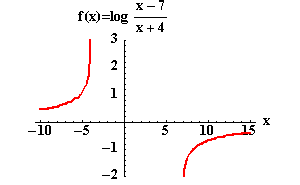 RULES OF LOGARITHMS - Example
RULES OF LOGARITHMS - Example
 RULES OF LOGARITHMS - Example
RULES OF LOGARITHMS - Example 
Let a be a positive number such that a does not equal 1, let
n be a real number, and let u and v be positive real numbers.
Logarithmic Rule 2:
![]()

Example 5: Expand  and state the domain.
and state the domain.
Solution: The domain of  is the set of all real numbers such that
is the set of all real numbers such that
![]()
Either x-7>0 and x+4>0 or x-7<0 and x+4<0 .
This means that if x > 7 and x > - 4, both the numerator and the
denominators are positive and the value of the fraction is positive. If we
restrict the values of x to be greater than 7, they are automatically
greater than - 4 and the domain can be simplified to x > 7.
or
This means that if x > 7 and x < -4, both the numerator and the denominator are negative, and the value of the fraction is positive. If we restrict the values of x to be less than - 4, they are automatically less than 7, and the domain can be simplified to x < -4.
The domain of  is the set of all real numbers that are in the interval
is the set of all real numbers that are in the interval ![]() or
or ![]() , that is
, that is
![]()
The domain of ![]() is the set of
real numbers that works for both. The real number x > 7 works for the
first term and the real number x > -4 works for the second term. You need a set of numbers that will work for both terms. The domain is the set of real numbers where x > 7.
is the set of
real numbers that works for both. The real number x > 7 works for the
first term and the real number x > -4 works for the second term. You need a set of numbers that will work for both terms. The domain is the set of real numbers where x > 7.
Therefore,  is equivalent to
is equivalent to ![]() only when the domain is restricted to those real numbers x > 7.
only when the domain is restricted to those real numbers x > 7.

| 
|
If you would like to review another example, click on Example.

 S.O.S.
MATHematics home page
S.O.S.
MATHematics home page